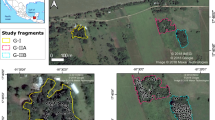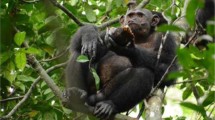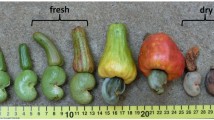Abstract
Complex food-processing techniques by gorillas, chimpanzees, and orangutans have allowed comparisons of complex hierarchical cognition between great apes and humans. Here, we analyse preliminary observations of free-ranging long-tailed macaques (Macaca fascicularis) (n = 3) in Thailand processing Opuntia sp. cactus fruits. From our observations, we suggest that there is potential to extend the analyses of hierarchical cognition to Old World monkeys. We found that the macaques used six behavioural sequences to obtain Opuntia fruits, remove irritant hairs from the skin of the fruits, and break open, and consume the fruits, each a unique combination of 17 action elements. Removing irritant hairs involved abrading fruits on a sand or rock substrate, and washing fruit in water. The behavioural sequences that macaques use to process Opuntia potentially show features of hierarchical organisation described in the leaf-processing behaviours of great apes. Our observations highlight the need for closer study of complex food-processing behaviour in monkeys to better understand the organisational capacities involved.



Similar content being viewed by others
References
Byrne RW (2005) The maker not the tool: the cognitive significance of great ape manual skills. In: Roux V, Bril B (eds) Stone knapping: the necessary conditions for a uniquely hominin behaviour. MacDonald Institute for Archaeological Research, Cambridge
Byrne RW, Byrne J (1993) Complex leaf-gathering skills of mountain gorillas (Gorilla g. berengei): variability and standardization. Am J of Primatol 31:241–261
Byrne RW, Russon AE (1998) Learning by imitation: a hierarchical approach. Behav Brain Sci 21: 667-690
Clark TW (1979) Food adaptations of a transplanted Japanese macaque troop (Arashiyama West). Primates 20:399–410
Dean WRJ, Milton SJ (2000) Directed dispersal of Opuntia species in the Karoo, South Africa: are crows the responsible agents? J Arid Environ 45:305–314
Feugang JM, Konarski P, Zou D, Stintxing FC, Zou C (2006) Nutritional and medicinal use of Cactus pear (Opuntia spp.) cladodes and fruits. Front Biosci 11:2574–2589
Gumert MD, Malaivijitnond S (2012) Marine prey processed with stone tools by Burmese long-tailed macaques (Macaca fascicularis aurea) in intertidal habitats. Am J Phys Anthropol 149:447–457
Gumert MD, Malaivijitnond S (2013) Long-tailed macaques select mass of stone according to food type. Phil Trans R Soc B 368:20120413
Isbell LA (1998) Diet for a small primate: insectivory and gummivory in the (large) patas monkey (Erythrocebus patas pyrrhonotus). Am J Primatol 45:381–398
Kelley EA (2013) The ranging behaviour of Lemur catta in the region of Cap Sainte-Marie, Madagascar. Am J of Phys Anthropol 150:122–132
Krishnamani R (1994) Diet composition of the bonnet macaque (Macaca radiata) in a tropical dry evergreen forest of southern India. Trop Biodivers 2:285–302
Lockman JJ (2000) A perception-action perspective on tool use development. Child Dev 71(1):137–144
Lotter WD, Thatcher L, Roussouw L, Reinhardt CF (1999) The influence of baboon predation and time in water on germination and early establishment of Opuntia stricta (Australian pest pear) in the Kruger National Park. Kowdoe 42:43–50
Parker ST, Gibson KR (1979) A developmental model for the evolution of language and intelligence in early hominids. Behav Brain Sci 2:367–408
Russel CE, Falkner P (1987) The prickly-pears (Opuntia spp., Cactaceae): a source of human and animal food in semiarid regions. Econ Bot 41:433–445
Russon AE (1998) The nature and evolution of intelligence in orangutans (Pongo pygmaeus). Primates 39:387–393
Stokes EJ, Byrne RW (2001) Cognitive capacities for behavioural flexibility in wild chimpanzees (Pan troglodytes): the effect of snare injury on complex manual food processing. Anim Cognit 4:11–28
Sugiyama Y (1997) Social traditions and the use of tool-composites by wild chimpanzees. Evol Anthropol 6:23–27
Tan A, Tan SH, Vyas D, Malaivijitnond S, Gumert M (2015) There is more than one way to crack an oyster: identifying variation in Burmese long-tailed macaque (Macaca fascicularis aurea) stone-tool use. PLoS One 10:e0124733
Visalberghi E, Fragaszy D (2006) What is challenging about tool use? The capuchin’s perspective. In: Wasserman EA, Zentall TR (eds) Comparative cognition: experimental explorations of animal intelligence. Oxford University Press, Oxford
Visalberghi E, Addessi E, Truppa V, Spagnoletti N, Ottoni E, Izar P, Fragaszy D (2009) Selection of effective stone tools by wild bearded capuchin monkeys. Curr Biol 19: 213–217
Acknowledgments
We thank the National Research Council of Thailand (NRCT) for permitting Amanda W. Y. Tan, Lydia Luncz, Michael Haslam, and Michael D. Gumert to conduct research in the Kingdom of Thailand, and the Department of National Parks, Wildlife, and Plant Conservation (DNP) for allowing our team to conduct research in Khao Sam Roi Yot National Park (KSRY). We thank Mr Runjroj Atsawakultarin, the superintendent of KSRY for administrative help, and the community of Phu Noi Village for logistical support and hospitality during our project. Thank you also to Ms Lauren O’Boyle for her field research assistance, and Mr Felix Merklinger for information on Opuntia cacti. The project has been funded by the Visiting Professor Scheme at the Department of Biology, Chulalongkorn University, the College of Humanities, Arts and Social Sciences (HASS) Incentive Grant Scheme, a Leakey Foundation Doctoral Research Grant, and a European Research Council Starting Grant No. 283959 (PRIMARCH).
Author information
Authors and Affiliations
Corresponding author
Electronic supplementary material
Below is the link to the electronic supplementary material.
Online resource 1. Video of the stages and elements involved in long-tailed macaques’ Opuntia processing techniques, Nom Sao Island. (MPG 48494 kb)
About this article
Cite this article
Tan, A.W.Y., Luncz, L., Haslam, M. et al. Complex processing of prickly pear cactus (Opuntia sp.) by free-ranging long-tailed macaques: preliminary analysis for hierarchical organisation. Primates 57, 141–147 (2016). https://doi.org/10.1007/s10329-016-0525-3
Received:
Accepted:
Published:
Issue Date:
DOI: https://doi.org/10.1007/s10329-016-0525-3




